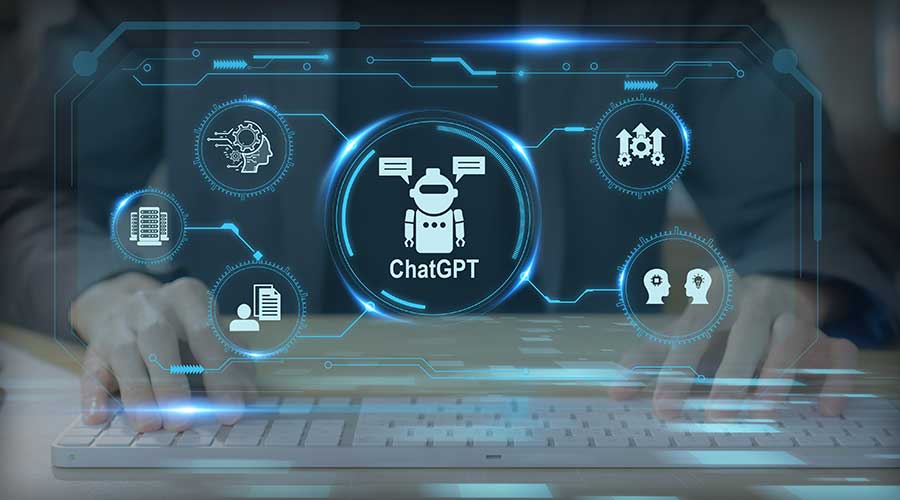Logistics companies bet on chat AI to assist customers
5/26/2023
By Grace Renderman, Associate Editor
ChatGPT, Bard and other large language-learning models are growing in popularity in many circles. The transportation and logistics sectors are among them — so much so that companies in those industries have begun rolling out their own artificial intelligence (AI)-powered chatbots to assist customers with shipment information and route recommendations.
A type of AI, large language-learning models are trained on a specific set of data, which helps teach them how to generate responses when posed a question. A chatbot doesn’t think for itself, although it seems as if it does. Instead, it uses its training material, as well as contextualization and understanding tools, to find the next best word to follow what it has already generated.
For general chatbots such as ChatGPT — which was developed by research lab OpenAI — the training material includes all sorts of things available on the internet, from books to videos to blogs to social media posts.
But the scope of knowledge needed for logistics models is much more specific — they need to access billions of data points from GPS sensors on containers and other shipping equipment around the world to determine where a customer’s shipment is, where it came from and where it’s going, or weather conditions and other useful information. The models can even recommend new or alternative routes for shipments in response to severe weather or port congestion.
Making data conversational
Swiss supply-chain solutions company Nexxiot earlier this month introduced its AI model, Scope AI. The model acts as an interactive chatbot interface with customers who can ask it questions about shipments and receive back data in a more digestible manner than just reviewing raw information, says Nexxiot CEO Stefan Kalmund.
“The intention [was] that we create something where it's so easy to actually dive into your own fleet,” he says. “It's really the same way any decision maker would try to understand their own organization.”
AI has already existed within Nexxiot’s internal operations for some time. Since it was founded in 2015, the company has used some form of AI to accomplish tasks, says Robert Lapins, Nexxiot’s head of product management who invented Scope AI. The model’s first iterations — for internal use — were developed about six months ago.
 Developed by research lab OpenAI, ChatGPT is a popular artificial intelligence-powered large language-learning model. Shutterstock
Developed by research lab OpenAI, ChatGPT is a popular artificial intelligence-powered large language-learning model. ShutterstockIt was only a matter of time before the company would develop public-facing versions for commercial use, but development was accelerated by other companies’ AI advancements, such as OpenAI and Google, which developed Bard, Lapins adds.
“We always had AI and machine learning teams, but I think the last couple of months have shown how important it is to actually create products out of it [for] end users,” Kalmund says.
Scope AI can be used on mobile devices and through speech to text, and is compatible with other companies’ shipment tracking technology. For example, ocean carrier Hapag-Lloyd has equipped its containers with Nexxiot devices alongside its own devices, Kalmund says.
So, what’s next for Scope AI?
With the base product now released to clients, Nexxiot plans to upgrade the model in phases in the near future. The product will evolve into an assistive model with an executive function, meaning it can make shipping decisions on a user’s behalf, Lapins says.
For now, Scope AI is a support tool, but the goal is to enhance it to work for the user and optimize decision making.
“We want to release these things at a steady pace to give users the ability to actually learn how to interact with these previous levels,” Lapins says. “We want to be careful in managing expectations.”
One benefit of using a generative language-learning model: Scope AI will learn over time as more customers use it and provide feedback on its pluses and minuses.
“The tool really becomes only as good as the data that you feed it,” Lapins adds.
The future of shipping decisions
It’s not just Nexxiot that is foraying into the AI commercialization space. Project44, a Chicago-based supply-chain visibility provider, is adding chat-interface AI capabilities to its existing platform, Movement. That platform is the company’s flagship visibility framework used by all Project44 clients.
Called MovementGPT, the new addition harkens back to the “GPT” in ChatGPT, which stands for generative pretrained transformer. It will accomplish tasks by having users enter questions about their shipment status, similar to Scope AI, says Project44 Chief Technology Officer Will Hansmann.
Movement was launched last year, and MovementGPT was rolled out earlier this month in an alpha pre-release version to select users. The product will be available to more users in the near future as the company continues to fine-tune and train it, Hansmann adds.
“The vision is for [MovementGPT] to become the key way in which our customers interact and answer their questions … in a way to unlock additional workflows and interactions through a super intuitive interface,” he says.
Much like Nexxiot and Scope AI, Project44 also was inspired by the explosive popularity of ChatGPT and other large language-learning models. ChatGPT and Bard became available to the public in November 2022 and March 2023, respectively.
In some ways, it’s harder to build an AI model specific to logistics needs, Hansmann says. That’s because there’s a “massive” amount of data and power behind the user interface supported by the billions of data points being received on a monthly basis that helps track every user’s shipment, he explains.
Not only does a model need to understand the basic foundations of the global supply chain, but also it requires the shipment data and supply-chain relationships needed to contextualize those data points.
“There is work that we need to do to train the model and make sure that it is responding within the scope that we want it to respond,” Hansmann says. “While sometimes people are working with ChatGPT or others and say, ‘Write me a story,’ we have simply put up some guardrails and training to say we're not here to be writing stories, we're here to respond to and make decisions on the data being presented.”
The biggest challenge in commercializing AI models? Getting customers to understand the limits of their capabilities, Hansmann believes.
“The biggest challenge will be for Project44 to continue to expand on this in the months and years to come to make this ever more powerful and solve more and more problems,” he says.


